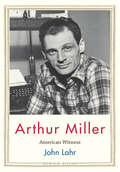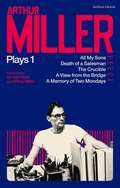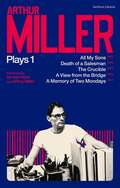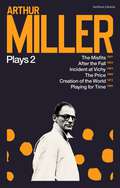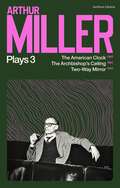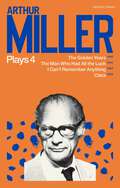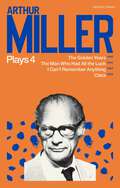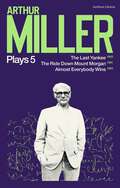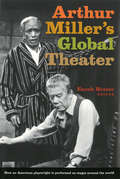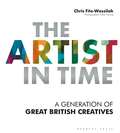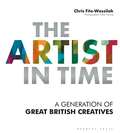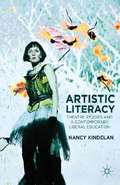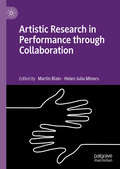- Table View
- List View
Arthur Miller: American Witness (Jewish Lives)
by John LahrA great theater critic brings twentieth-century playwright Arthur Miller’s dramatic story to life with bold and revealing new insights “New Yorker critic Lahr shines in this searching account of the life of playwright Arthur Miller. . . . It’s a great introduction to a giant of American letters.”—Publishers Weekly Distinguished theater critic John Lahr brings unique perspective to the life of Arthur Miller (1915–2005), the playwright who almost single-handedly propelled twentieth-century American theater into a new level of cultural sophistication. Organized around the fault lines of Miller’s life—his family, the Great Depression, the rise of fascism, Elia Kazan and the House Committee on Un-American Activities, Marilyn Monroe, Vietnam, and the rise and fall of Miller’s role as a public intellectual—this book demonstrates the synergy between Arthur Miller’s psychology and his plays. Concentrating largely on Miller’s most prolific decades of the 1940s, 1950s, and 1960s, Lahr probes Miller’s early playwriting failures; his work writing radio plays during World War II after being rejected for military service; his only novel, Focus; and his succession of award-winning and canonical plays that include All My Sons, Death of a Salesman, and The Crucible, providing an original interpretation of Miller’s work and his personality.
Arthur Miller for the Twenty-First Century: Contemporary Views of His Writings and Ideas (American Literature Readings in the 21st Century)
by Stephen Marino David PalmerArthur Miller for the Twenty-First Century: Contemporary Views of His Writings and Ideas brings together both established Miller experts and emerging commentators to investigate the sources of his ongoing resonance with audiences and his place in world theatre. The collection begins by exploring Miller in the context of 20th-century American drama. Chapters discuss Miller and Eugene O’Neill, Tennessee Williams, Edward Albee, David Mamet, and Sam Shepard, as well as thematic relationships between Miller’s ideas and the explosion of significant women and African American dramatists since the 1970s. Other essays focus more directly on interpretations of Miller’s individual works, not only plays but also essays and fiction, including a discussion of Death of a Salesman in China. The volume concludes by considering Miller and current cultural issues: his work for human rights, his depiction of American ideals of masculinity, and his anticipation of contemporary posthumanism.
Arthur Miller Plays 1: All My Sons; Death of a Salesman; The Crucible; A Memory of Two Mondays; A View from the Bridge
by Arthur Miller"The greatest American dramatist of our age." (Evening Standard)In this collected works, five of Arthur Miller's most-produced and popular plays are brought together in a new edition, alongside an exclusive introduction by Ivo van Hove, the celebrated contemporary director of Miller's works.All five plays were written by Miller within a ten-year period which began with his first Broadway hit, All My Sons, in 1947 which led Brooks Atkinson of the New York Times to state that 'theatre has acquired a genuine new talent.' This was followed in 1949 by his exploration of the American Dream in Death of a Salesman, which went on to win the Tony Award for Best Play and the Pulitzer Prize for Drama.The Crucible followed in 1953, produced during the McCarthy era and becoming a parable of the witch-hunting practices of a government determined to root-out Communists. A View from the Bridge, originally performed in 1955, concerns the lives of longshoremen in the Brooklyn waterfront and has remained one of Miller's most produced plays. Originally presented as a one-act companion piece to A Memory of Two Mondays, both plays explore the dreams and working lives of ordinary Americans in the early decades of the 20th century.Freshly edited and featuring a bold new design, this updated edition of Arthur Miller Plays 1is a must-have for theatre fans and students alike.
Arthur Miller Plays 1: All My Sons; Death of a Salesman; The Crucible; A Memory of Two Mondays; A View from the Bridge
by Arthur Miller"The greatest American dramatist of our age." (Evening Standard)In this collected works, five of Arthur Miller's most-produced and popular plays are brought together in a new edition, alongside an exclusive introduction by Ivo van Hove, the celebrated contemporary director of Miller's works.All five plays were written by Miller within a ten-year period which began with his first Broadway hit, All My Sons, in 1947 which led Brooks Atkinson of the New York Times to state that 'theatre has acquired a genuine new talent.' This was followed in 1949 by his exploration of the American Dream in Death of a Salesman, which went on to win the Tony Award for Best Play and the Pulitzer Prize for Drama.The Crucible followed in 1953, produced during the McCarthy era and becoming a parable of the witch-hunting practices of a government determined to root-out Communists. A View from the Bridge, originally performed in 1955, concerns the lives of longshoremen in the Brooklyn waterfront and has remained one of Miller's most produced plays. Originally presented as a one-act companion piece to A Memory of Two Mondays, both plays explore the dreams and working lives of ordinary Americans in the early decades of the 20th century.Freshly edited and featuring a bold new design, this updated edition of Arthur Miller Plays 1is a must-have for theatre fans and students alike.
Arthur Miller Plays 2: The Misfits; After the Fall; Incident at Vichy; The Price; Creation of the World; Playing for Time
by Arthur Miller"The greatest American dramatist of our age" - Evening Standard In this second volume of collected works, four of Arthur Miller's stage plays from the sixties and seventies are brought together in a new edition. Taking up the theme of individual responsibility from his earlier work, this volume also contains an introduction from Miller himself, along with two of his screenplays. One of Miller's most personal plays, After the Fall (1964) takes place almost entirely inside the mind of the play's protagonist, who is often read as a stand-in for the playwright himself, and touches on themes of the Holocaust, McCarthyism and inherited sin. This was followed by Miller's largely forgotten masterpiece, Incident at Vichy (1964): a prescient examination of the evil that exists in us all, inspired by a real-life incident in France in which a Gentile gave a Jew his identity pass during a check. The Price followed in 1968, a touching and farcical presentation of American life beyond the Vietnam War and Great Depression, which earned Miller a Tony Award nomination for Best Play. In The Creation of the World and Other Business (1972), Miller offers a comedic retelling of the Book of Genesis, constructing a parable around the theme of good-versus-evil. Also included are two of the playwright's most beloved screenplays: The Misfits, written for and filmed with Marilyn Monroe, and Playing for Time, televised with Vanessa Redgrave. Freshly edited and featuring a bold new design, this updated edition of Arthur Miller Plays 2 is a must-have for theatre fans and students alike.
Arthur Miller Plays 2: The Misfits; After the Fall; Incident at Vichy; The Price; Creation of the World; Playing for Time
by Arthur Miller"The greatest American dramatist of our age" - Evening Standard In this second volume of collected works, four of Arthur Miller's stage plays from the sixties and seventies are brought together in a new edition. Taking up the theme of individual responsibility from his earlier work, this volume also contains an introduction from Miller himself, along with two of his screenplays. One of Miller's most personal plays, After the Fall (1964) takes place almost entirely inside the mind of the play's protagonist, who is often read as a stand-in for the playwright himself, and touches on themes of the Holocaust, McCarthyism and inherited sin. This was followed by Miller's largely forgotten masterpiece, Incident at Vichy (1964): a prescient examination of the evil that exists in us all, inspired by a real-life incident in France in which a Gentile gave a Jew his identity pass during a check. The Price followed in 1968, a touching and farcical presentation of American life beyond the Vietnam War and Great Depression, which earned Miller a Tony Award nomination for Best Play. In The Creation of the World and Other Business (1972), Miller offers a comedic retelling of the Book of Genesis, constructing a parable around the theme of good-versus-evil. Also included are two of the playwright's most beloved screenplays: The Misfits, written for and filmed with Marilyn Monroe, and Playing for Time, televised with Vanessa Redgrave. Freshly edited and featuring a bold new design, this updated edition of Arthur Miller Plays 2 is a must-have for theatre fans and students alike.
Arthur Miller Plays 3: The American Clock; The Archbishop's Ceiling; Two-Way Mirror
by Arthur Miller"The greatest American dramatist of our age" - Evening Standard In this third volume of collected works, three of Arthur Miller's stage plays from the early 1980s are brought together in a new edition. Expanding on the themes and explorations of his earlier work, this volume also contains an introduction from the playwright himself, as well as an afterword by acclaimed Miller scholar Christopher Bigsby. A sweeping, hard-hitting look at the Great Depression of the 1930s, The American Clock(1982) is a vaudevillian celebration of American resilience and optimism in the face of national crisis, and was later performed on Broadway. Set in an Eastern European capital, The Archbishop's Ceiling (1984), examines the relationship between four writers, and the erosion of personal integrity during the cold war: a thrilling study of the effects of surveillance and political pressure on an individual's actions Also included is a revised version of Two-Way Mirror (1984): a double bill for a man and a woman, consisting of two short plays - Elegy for a Lady and Some Kind of Love Story. These fantastic two-handers explore the nuances in relationships, and have come to be come to be recognised as some sort of coded epitaph to the tumult and tragedy of Miller's marriage to Marilyn Monroe Freshly edited and featuring a bold new design, this updated edition of Arthur Miller Plays 3 is a must-have for theatre fans and students alike.
Arthur Miller Plays 3: The American Clock; The Archbishop's Ceiling; Two-Way Mirror
by Arthur Miller"The greatest American dramatist of our age" - Evening Standard In this third volume of collected works, three of Arthur Miller's stage plays from the early 1980s are brought together in a new edition. Expanding on the themes and explorations of his earlier work, this volume also contains an introduction from the playwright himself, as well as an afterword by acclaimed Miller scholar Christopher Bigsby. A sweeping, hard-hitting look at the Great Depression of the 1930s, The American Clock(1982) is a vaudevillian celebration of American resilience and optimism in the face of national crisis, and was later performed on Broadway. Set in an Eastern European capital, The Archbishop's Ceiling (1984), examines the relationship between four writers, and the erosion of personal integrity during the cold war: a thrilling study of the effects of surveillance and political pressure on an individual's actions Also included is a revised version of Two-Way Mirror (1984): a double bill for a man and a woman, consisting of two short plays - Elegy for a Lady and Some Kind of Love Story. These fantastic two-handers explore the nuances in relationships, and have come to be come to be recognised as some sort of coded epitaph to the tumult and tragedy of Miller's marriage to Marilyn Monroe Freshly edited and featuring a bold new design, this updated edition of Arthur Miller Plays 3 is a must-have for theatre fans and students alike.
Arthur Miller Plays 4: The Golden Years; The Man Who Had All the Luck; I Can't Remember Anything; Clara
by Arthur Miller"Listen to the dialogue: no other American dramatist has this feel for the ordinary talk of ordinary people, or the knowledge of what they do. This is more than a writer's craft, it is a psychological and moral openness to humanity, an act not of imitating, but of sharing". Sunday TimesThis fourth anthology features Arthur Miller's two early plays, The Golden Years, a historical tragedy about Montezuma's destruction at the hands of Cortez, and The Man Who Had All the Luck, a fable about human freedom and individual responsibility, are brought together in this volume. It also features two of his contemporary shorter plays, I Can't Remember Anything and Clara, first presented on a double bill as Danger! Memory. The latter focus on the importance and dangers of remembering the past, while the early plays, written at the time of the Second World War, mark the emergence of a drama in which public issues are rooted in private anxieties and chart the beginning of Miller's career that was one of the most distinguished in dramatic history.First produced in 1944 and revived in London in 2008, The Man Who Had All the Luck is a mesmerising drama in which the author's brilliance and characteristic qualities are already evident: The fourth volume of Miller's plays has been reissued with a new cover and features an introduction by the author and a chronology of his work.
Arthur Miller Plays 4: The Golden Years; The Man Who Had All the Luck; I Can't Remember Anything; Clara
by Arthur Miller"Listen to the dialogue: no other American dramatist has this feel for the ordinary talk of ordinary people, or the knowledge of what they do. This is more than a writer's craft, it is a psychological and moral openness to humanity, an act not of imitating, but of sharing". Sunday TimesThis fourth anthology features Arthur Miller's two early plays, The Golden Years, a historical tragedy about Montezuma's destruction at the hands of Cortez, and The Man Who Had All the Luck, a fable about human freedom and individual responsibility, are brought together in this volume. It also features two of his contemporary shorter plays, I Can't Remember Anything and Clara, first presented on a double bill as Danger! Memory. The latter focus on the importance and dangers of remembering the past, while the early plays, written at the time of the Second World War, mark the emergence of a drama in which public issues are rooted in private anxieties and chart the beginning of Miller's career that was one of the most distinguished in dramatic history.First produced in 1944 and revived in London in 2008, The Man Who Had All the Luck is a mesmerising drama in which the author's brilliance and characteristic qualities are already evident: The fourth volume of Miller's plays has been reissued with a new cover and features an introduction by the author and a chronology of his work.
Arthur Miller Plays 5: The Last Yankee; The Ride Down Mount Morgan; Almost Everybody Wins
by Arthur Miller"The greatest American dramatist of our age" Evening StandardThis fifth volume of Arthur Miller's work contains two plays from the early nineties: his highly acclaimed The Last Yankee (1993), which the Guardian called "a fine and moving play . . . Like all Miller's best work, it effortlessly links private and public worlds by connecting personal desperation to insane American values"; and The Ride Down Mount Morgan (1991), which explores themes of bigamy and betrayal, described as "searching, scorching, harsh but compassionate" (Sunday Times). Also contained in the volume is Almost Everybody Wins, the original version of the screenplay Arthur Miller wrote for Karel Reisz's film, "Everybody Wins".
Arthur Miller Plays 5: The Last Yankee; The Ride Down Mount Morgan; Almost Everybody Wins
by Arthur Miller"The greatest American dramatist of our age" Evening StandardThis fifth volume of Arthur Miller's work contains two plays from the early nineties: his highly acclaimed The Last Yankee (1993), which the Guardian called "a fine and moving play . . . Like all Miller's best work, it effortlessly links private and public worlds by connecting personal desperation to insane American values"; and The Ride Down Mount Morgan (1991), which explores themes of bigamy and betrayal, described as "searching, scorching, harsh but compassionate" (Sunday Times). Also contained in the volume is Almost Everybody Wins, the original version of the screenplay Arthur Miller wrote for Karel Reisz's film, "Everybody Wins".
Arthur Miller Plays 6: Broken Glass; Mr Peters' Connections; Resurrection Blues; Finishing the Picture
by Arthur MillerThe final volume in Methuen Drama's acclaimed series of work by Arthur Miller who, during his lifetime, was acknowledged as "the greatest American dramatist of our age" (Evening Standard). Featuring two plays from the 1990s and his final two plays (2002 and 2004), it offers the first ever publication of Miller's final play, Finishing the Picture. Inspired by his experience during the filming of The Misfits with his then wife Marilyn Monroe, the play was completed and produced at the Goodman Theatre, Chicago, just months before the playwright's death in February 2005.Broken Glass (1994) is set in Brooklyn in 1938 and intertwines a woman's obsession with the news from Germany that government thugs are smashing Jewish stores, with her strange relationship with her husband. "It balances private lives with public morality. . . it is also an amazingly full-blooded piece, bursting with pain and passion." (Daily Telegraph). Mr Peters' Connections (1998) is an unforgettable journey through one man's mind at a time of suspended consciousness, where the living and dead intermingle in his memory. Resurrection Blues (2002) is Miller's astonishing black comedy set in a South American banana republic, that satirises global politics and the predatory nature of a media saturated culture.The volume also features a chronology of the writer's work and an introduction by Enoch Brater, professor of English Literature at the University of Michigan.
Arthur Miller Plays 6: Broken Glass; Mr Peters' Connections; Resurrection Blues; Finishing the Picture
by Arthur MillerThe final volume in Methuen Drama's acclaimed series of work by Arthur Miller who, during his lifetime, was acknowledged as "the greatest American dramatist of our age" (Evening Standard). Featuring two plays from the 1990s and his final two plays (2002 and 2004), it offers the first ever publication of Miller's final play, Finishing the Picture. Inspired by his experience during the filming of The Misfits with his then wife Marilyn Monroe, the play was completed and produced at the Goodman Theatre, Chicago, just months before the playwright's death in February 2005.Broken Glass (1994) is set in Brooklyn in 1938 and intertwines a woman's obsession with the news from Germany that government thugs are smashing Jewish stores, with her strange relationship with her husband. "It balances private lives with public morality. . . it is also an amazingly full-blooded piece, bursting with pain and passion." (Daily Telegraph). Mr Peters' Connections (1998) is an unforgettable journey through one man's mind at a time of suspended consciousness, where the living and dead intermingle in his memory. Resurrection Blues (2002) is Miller's astonishing black comedy set in a South American banana republic, that satirises global politics and the predatory nature of a media saturated culture.The volume also features a chronology of the writer's work and an introduction by Enoch Brater, professor of English Literature at the University of Michigan.
Arthur Miller Volume 2: 1962-2005
by Christopher BigsbyDefinitive second volume of biography of one of the greatest modern playwrights, Arthur Miller (1915-2005). The first volume of Christopher Bigsby's award-winning biography of Arthur Miller was hailed as a masterpiece and the definitive account of Miller's early years. Here, now, is the second half of Miller's captivating story, taking the story from 1962 to his death in 2005. In 1962, Miller's legacy was incomplete. Ahead lay eighteen plays, five films, a novella and a handful of stories. On a personal level, 1962 saw the death of his second wife, the iconographic Marilyn Monroe, and his marriage to the Magnum photographer Inge Morath who was to transform him as a writer and a person. A visit to Mauthaussen concentration camp and to the Frankfurt trials of Auschwitz-Birkenau guards moved the Holocaust to the centre of his attention. He became a more directly political person, and met such statesmen as Mikhail Gorbachev, Nelson Mandela and Fidel Castro. In terms of his writing, one of the paradoxes of the last thirty years of his life was the fact that many American critics treated him with some suspicion, and even disdain, at the very moment his new work was being hailed internationally. This volume explores some of the reasons for the divergent views of a writer who not only captured a changing America but helped to change it. Christopher Bigsby brilliantly and elegantly maps out the journey of Miller's life and work. Shedding new light on Miller's complexities, and revealing unknown facts about his public and private life, Bigsby shares new insights and perspectives crucial to an understanding of one of the world's greatest playwrights.
Arthur Miller's Global Theater
by Enoch BraterNo American playwright is more revered on the international stage than Arthur Miller. In Arthur Miller’s Global Theater—a fascinating collection of new essays by leading international critics and scholars—readers learn how and why audiences around the world have responded to the work of the late theatrical icon. With perspectives from diverse corners of the globe, from Israel to Japan to South Africa, this groundbreaking volume explores the challenges of translating one of the most American of American playwrights and details how disparate nations have adapted meaning in Miller’s most celebrated dramas. An original and engaging collection that will appeal to theater aficionados, scholars, students, and all those interested in Miller and his remarkable oeuvre, Arthur Miller’s Global Theater illustrates how dramas such as Death of a Salesman,The Crucible, and A View from the Bridge developed a vigorous dialogue with new audiences when they crossed linguistic and national borders. In these times when problems of censorship, repressive regimes, and international discord are increasingly in the news, Arthur Miller’s voice has never been more necessary as it continues to be heard and celebrated around the world. Enoch Brater is the Kenneth T. Rowe Collegiate Professor of Dramatic Literature at the University of Michigan. His other books include Arthur Miller: A Playwright’s Life and Works and Arthur Miller’s America.
Arthur's World (Oberon Modern Plays)
by Helena ThompsonArthur is an OAP, hiding out from the world in his grotty top-floor council flat. He’d move – if it weren’t for his missing son. Today is Michael’s twentieth birthday – will he finally come home? But the person Arthur finally lets in turns out to be someone else entirely. This teenager is seeking refuge from The Fights – the raging riots sparked years ago by a notorious computer game.
The Artificial Body in Fashion and Art: Marionettes, Models and Mannequins
by Adam GeczyArtificial bodies constructed in human likeness, from uncanny automatons to mechanical dolls, have long played a complex and subtle role in human identity and culture. This book takes a range of these bodies, from antiquity to the present day, to explore how we seek out echoes, caricatures and replications of ourselves in order to make sense of the complex world in which we live. Packed with case studies, from the commedia del'arte to Hans Bellmer and the 1980s supermodel, this volume explores the divide between the "real†? and the constructed. Arguing that the body "other†? plays a crucial role in the formation of the self physically and psychologically, leading scholar Adam Geczy contends that the "natural†? body has been replaced by a series of imaginary archetypes in our post-modern world, central to which is the figure of the doll. The Artificial Body in Fashion and Art provides a much-needed synthesis of constructed bodies across time and place, drawing on fashion theory, theatre studies and material culture, to explore what the body means in the realms of identity, gender, performance and art.
The Artificial Body in Fashion and Art: Marionettes, Models and Mannequins
by Adam GeczyArtificial bodies constructed in human likeness, from uncanny automatons to mechanical dolls, have long played a complex and subtle role in human identity and culture. This book takes a range of these bodies, from antiquity to the present day, to explore how we seek out echoes, caricatures and replications of ourselves in order to make sense of the complex world in which we live. Packed with case studies, from the commedia del'arte to Hans Bellmer and the 1980s supermodel, this volume explores the divide between the “real” and the constructed. Arguing that the body “other” plays a crucial role in the formation of the self physically and psychologically, leading scholar Adam Geczy contends that the “natural” body has been replaced by a series of imaginary archetypes in our post-modern world, central to which is the figure of the doll. The Artificial Body in Fashion and Art provides a much-needed synthesis of constructed bodies across time and place, drawing on fashion theory, theatre studies and material culture, to explore what the body means in the realms of identity, gender, performance and art.
The Artist in Time: A Generation of Great British Creatives
by Chris Fite-WassilakThe Artist in Time brings together twenty creatives from across the UK, with photographs and interviews that disclose their daily working habits and motivations. All born before 1950, this is a collective portrait of a generation who have shaped our artistic landscape. They provide a range of different answers to the question 'what makes an artist?', and a set of insights into what makes up a creative life. Giving the reader access to the studio and working spaces of a diverse group of painters, poets, choreographers, filmmakers, illustrators, musicians, photographers, sculptors, writers and creators, The Artist in Time is a handbook for creativity and inspiration, made up of artists from all backgrounds who have all in their own way shaped, and continue to shape, the creative landscape of the United Kingdom.
The Artist in Time: A Generation of Great British Creatives
by Chris Fite-WassilakThe Artist in Time brings together twenty creatives from across the UK, with photographs and interviews that disclose their daily working habits and motivations. All born before 1950, this is a collective portrait of a generation who have shaped our artistic landscape. They provide a range of different answers to the question 'what makes an artist?', and a set of insights into what makes up a creative life. Giving the reader access to the studio and working spaces of a diverse group of painters, poets, choreographers, filmmakers, illustrators, musicians, photographers, sculptors, writers and creators, The Artist in Time is a handbook for creativity and inspiration, made up of artists from all backgrounds who have all in their own way shaped, and continue to shape, the creative landscape of the United Kingdom.
The Artist Man and the Mother Woman (Modern Plays)
by Morna PearsonHow my wee boy, as naive and pastey as he is, could get a grown woman tae go weak at the knees, screaming, as it appears you wis last night. When he's nae so much as accidently brushed up against a wifie afore, and there's nae internet or dirty magazines in the hoose tae speak o. And I ken, I've checked under his mattress. Nut, nae contact wi anither female in the world. Oh. 'Cept his mammy o course. 'Cept his mammy. Geoffrey Buncher is an art teacher. Until now his only meaningful relationship has been with his mother, Edie, who doesn't want her 'wee man growing up too fast'. But when one day he reads in the newspaper that he's working in amongst the top ten sexiest professions, he decides to advertise in the local papers for a wife. Straying outside of his comfortable existence where his mother continues to buy her middle-aged son's Ribena, Geoffrey enters a frightening world of adulthood and female companionship that he struggles to adjust to. Attraction manifests itself in warped and disturbing ways and leads to a terrifying conclusion.Written in Morna Pearson's trademark 'lurid, post-modern Doric' (Scotsman), and with hints of Joe Orton and Harold Pinter, The Artist Man and the Mother Woman is a wickedly funny, deceptively simple, surreal portrait of a spectacularly dysfunctional relationship.This world premiere was staged by the Traverse Theatre Company in the Traverse One space between 30 October and 17 November 2012, directed by Orla O'Loughlin.
The Artist Man and the Mother Woman: Caledonia; Bullet Catch; The Artist Man And Mother Woman; Narrative; Rantin' (Modern Plays)
by Morna PearsonHow my wee boy, as naive and pastey as he is, could get a grown woman tae go weak at the knees, screaming, as it appears you wis last night. When he's nae so much as accidently brushed up against a wifie afore, and there's nae internet or dirty magazines in the hoose tae speak o. And I ken, I've checked under his mattress. Nut, nae contact wi anither female in the world. Oh. 'Cept his mammy o course. 'Cept his mammy. Geoffrey Buncher is an art teacher. Until now his only meaningful relationship has been with his mother, Edie, who doesn't want her 'wee man growing up too fast'. But when one day he reads in the newspaper that he's working in amongst the top ten sexiest professions, he decides to advertise in the local papers for a wife. Straying outside of his comfortable existence where his mother continues to buy her middle-aged son's Ribena, Geoffrey enters a frightening world of adulthood and female companionship that he struggles to adjust to. Attraction manifests itself in warped and disturbing ways and leads to a terrifying conclusion.Written in Morna Pearson's trademark 'lurid, post-modern Doric' (Scotsman), and with hints of Joe Orton and Harold Pinter, The Artist Man and the Mother Woman is a wickedly funny, deceptively simple, surreal portrait of a spectacularly dysfunctional relationship.This world premiere was staged by the Traverse Theatre Company in the Traverse One space between 30 October and 17 November 2012, directed by Orla O'Loughlin.
Artistic Literacy: Theatre Studies and a Contemporary Liberal Education (The Arts in Higher Education)
by N. KindelanExploring the ways undergraduate theatre programs can play a significant role in accomplishing the aims and learning outcomes of a contemporary liberal education, Kindelan argues that theatre's signature pedagogy helps all undergraduates become actively engaged in developing critical and value-focused skills.
Artistic Research in Performance through Collaboration
by Martin Blain Helen Julia MinorsThis volume explores the issue of collaboration: an issue at the centre of Performance Arts Research. It is explored here through the different practices in music, dance, drama, fine art, installation art, digital media or other performance arts. Collaborative processes are seen to develop as it occurs between academic researchers in the creative arts and professional practitioners in commercial organisations in the creative arts industries (and beyond), as well as focusing attention and understanding on the tacit/implicit dimensions of working across different media.
